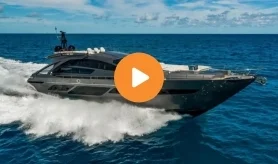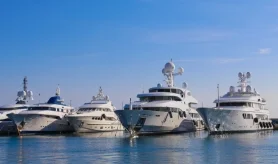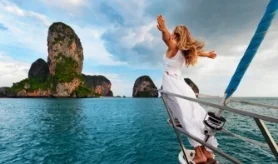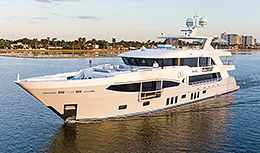- Alaskan Yachts
- Azimut Yachts
- Back Cove Yachts
- Beneteau Yachts
- Benetti Superyachts
- Bertram Yachts
- Boston Whaler
- Broward Yachts
- Buddy Davis Sportfish
- Burger Yachts
- Cabo Yachts
- Catamarans
- Carver Motoryachts
- Center Console
- Chris-Craft Yachts
- Cruisers Yachts
- DeFever Trawlers
- Dufour Sailboats
- Fairline Yachts
- Feadship Yachts
- Ferretti Yachts
- Formula Yachts
- Fountaine Pajot Cats
- Grady-White
- Grand Banks Trawlers
- Hargrave Yachts
- Hatteras Yachts
- Hinckley Picnic Boats
- Horizon Yachts
- Hydra-Sports
- Intrepid Boats
- Jarrett Bay Sportfish
- Jeanneau Yachts
- Kadey-Krogen Trawlers
- Lazzara Yachts
- Lekker Boats
- Luhrs Sportfish
- Marlow Yachts
- Maritimo Yachts
- Marquis Yachts
- McKinna Motoryachts
- Meridian Yachts
- Midnight Express
- MJM Yachts
- Mochi Craft
- Neptunus Motoryachts
- Nordhavn Trawlers
- Nordic Tugs
- Numarine Yachts
- Ocean Alexander Yachts
- Offshore Yachts
- Outer Reef
- Oyster Sailing Yachts
- Pacific Mariner Yachts
- Palmer Johnson Yachts
Birds of New Zealand: Spread Your Wings
Dubbed the “Galapagos of the Southern Ocean”, New Zealand’s Subantarctic Islands are some of the most remote archipelagos in the world and home to a remarkable group of land and sea birds.
Set in the unforgiving Southern Ocean, the five groups of New Zealand’s windswept Subantarctic Islands – Antipodes Islands, Auckland Islands, Bounty Islands, Campbell Island, and Snares Islands – are closely protected UNESCO World Heritage Sites, with very limited and strict access requirements*. If you choose to experience them aboard a hardy expedition yacht, you will find yourself in the heart of an undisturbed avian kingdom. Best visited in peak summer, from December to January, make sure to ready your sea legs – this Southern Hemisphere ocean can be wild!
DAY ONE
Bluff, Invercargill
An overnight cruise from Bluff, New Zealand’s southernmost settlement, will take you towards The Snares – named because they were once believed to be a dangerous snare for passing ships. They sit some 200km south of Invercargill. Settle in on board and brush up on the many bird species you’ll encounter over the coming weeks. First up is the great-winged northern royal albatross, which you can expect to see gracing the skies on your approach.

DAY TWO
The Snares
Completely uninhabited, the Snares have never had mammals introduced and are therefore a complete haven for seabirds, many of whom use the islands as a breeding spot. Because of this, it’s not possible to land on any of the five islands, but if weather permits you can get up close to the shoreline by Zodiac and try to spot the endemic Snares Island tomtit (the Australasian robin) and Snares Island fernbird. More than a million sooty shearwaters arrive at The Snares each spring for breeding season, while another prolific bird is the diving petrel. You will likely even see Snares crested penguins swimming alongside you as you approach the shoreline – they have over 100 colonies on the islands and are unique to this small 4km landmass.

DAY THREE
Enderby Island, Auckland Islands
Leave the Snares behind for the Auckland Islands, which lie 465km south of Invercargill. The Auckland Islands are the remains of two volcanos and warrant a visit of several days as they are the largest of the Subantarctic Islands. Home to both land and sea birds, these islands are an important breeding ground for many species. Start your Auckland Islands experience by stepping ashore to visit beautiful Enderby Island, which is notable for its population of the rare and shy yellow-eyed penguins. Spot the Auckland Island flightless teal too, and perhaps a majestic royal albatross.

DAY FOUR
Auckland Island, Auckland Islands
Auckland Island, namesake of the island group, boasts imposing cliffs and glacier-carved landscapes. Anchor in Carnley Harbour and travel ashore to explore the island, which promises sightings of many birds including the Auckland shag and the sooty shearwater. Of note, a shy mollymawk albatross colony can be found on South West Cape. Look above you and you’re likely to spot the wandering albatross soaring over the island.

DAY FIVE
Campbell Island
Campbell Island is the furthest south of the Subantarctic Islands – 700km south of Invercargill. Once a remote settlement, today Campbell Island is a densely covered haven for wildlife and seabirds. Look out for the long-beaked Campbell Island snipe, which was only discovered in 1997, and the Campbell Island teal. The island is home to six types of albatross including the light-mantled sooty and the Gibson’s wandering albatross. If you’re lucky, you’ll witness “gaming,” where two albatross meet in the air in a type of courtship display, which is a marvelous spectacle.

DAY SIX
Campbell Island
Spend a second day on Campbell Island and walk along the Col Lyall Boardwalk to reach the breeding grounds of the southern royal albatross – 99% of this type of albatross breed on this island. “Incubating albatrosses sit for weeks, mostly in a state of broodiness or torpor to conserve energy,” observes specialist bird photographer Cliff Beittel, who visited Campbell Island in 2012. “It’s strange to see these avian athletes so inactive; When they’re not nesting, southern royals circle the globe, feeding not only off New Zealand, but off South America and the Antarctic Peninsula.” Alternatively, take the longer option of a hike from Northwest Bay. Enjoy the scenery and look for Campbell Island shags and nesting giant petrels. Cruise overnight back towards Bluff.

DAY SEVEN
Bluff, Invercargill
Finish the long journey back to port. It’s not farewell to your new winged friends just yet as you’ll be joined by seabirds as you cruise. The trip back is a good opportunity to reflect on the special range of species you witnessed in their natural environment. They don’t call the Subantarctic Islands one of the world’s best kept secrets for nothing.

*All vessels looking to access the coastal marine area around the Subantarctic Islands must undergo a clean hull inspection to be assessed for biosecurity risk and will require a coastal permit. All detailed requirements can be found at: www.doc.govt.nz/about-us/our-role/managing-conservation/coastal-management/regional-coastal-plan-kermadec-and-subantarctic-islands/
FUN FACTS
01
Fernbirds – named kōtātā or mātātā in Māori – have a gamey smell, which makes them irresistible to dogs trained for game hunting or as conservation dogs.
02
Diving petrels use their feet and tail as rudders; experiments have shown that the common diving petrel can dive to 210 foot.
03
Yellow-eyed penguins are known for being shy. In fact, unlike other penguin species, they don’t nest within visual sight of each other.
04
The Auckland Island flightless teal is actually a duck, a species of dabbling duck, and can be found on Adams Island, Enderby Island, and the ominously named Disappointment Island.
05
No one knew there was such a bird as a Campbell Island snipe before November 1997. For about 170 years they had been confined to a tiny, sheer-sided rock stack off the south coast of Campbell Island. They were discovered by chance when three explorers landed by helicopter on Jacquemart Island searching for Campbell Island teal and their three trained bird-locater dogs found the snipe.
06
The wandering albatross has the longest wingspan of any bird, measuring up to 11 feet.
07
The Snare Island snape is nocturnal. When nesting, the couples share parenting duties; the male looks after the first chick to leave the nest, while the female takes care of the second.
Request a Copy [FRANK Issue 2]
From intelligent debate to cutting-edge science, and risky sports to surreal charter experiences, FRANK does not shy away from the awkward, controversial, or questionable details. Brazen at times, amusing in spirit, and always transparent in discussion, the focus is on discovering new angles and enjoying every minute. And, of course, always being ‘frank’ about the conclusions.
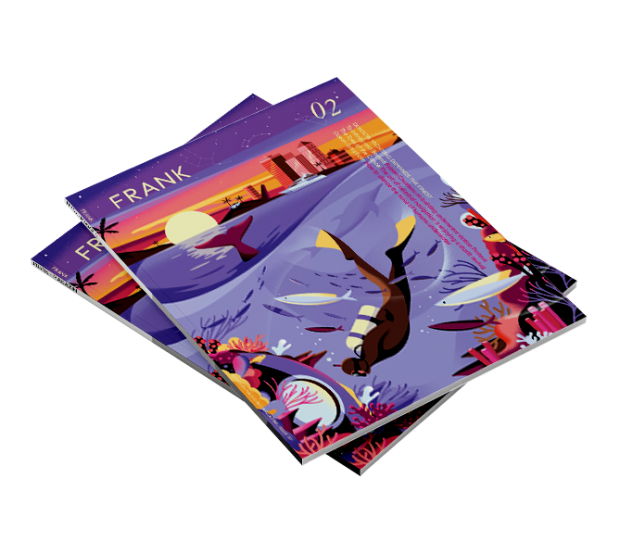
Request A Copy
